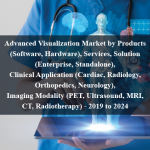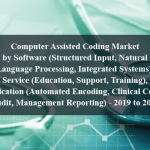OVERVIEW
The IoT Medical Devices Market is currently valued at USD 41.5 billion in 2024 and will be growing at a CAGR of 32.1% over the forecast period to reach an estimated USD 166.5 billion in revenue in 2029. The IoT medical devices market has seen exponential growth in recent years, revolutionizing the healthcare industry. These devices utilize Internet of Things (IoT) technology to collect, transmit, and analyze patient data in real-time, offering healthcare providers valuable insights for diagnosis, treatment, and monitoring. From wearable fitness trackers to advanced remote patient monitoring systems, IoT medical devices encompass a wide range of applications, spanning chronic disease management, elderly care, hospital asset tracking, and more. Key drivers fueling the market’s expansion include the increasing prevalence of chronic diseases, growing demand for remote patient monitoring solutions, and advancements in sensor technology and connectivity. Moreover, the COVID-19 pandemic has accelerated the adoption of telemedicine and remote monitoring, further propelling the demand for IoT medical devices. However, along with the opportunities, challenges such as data privacy concerns, interoperability issues, and regulatory hurdles also need to be addressed to ensure the widespread adoption and seamless integration of IoT devices into healthcare workflows.
The rising prevalence of chronic diseases, such as diabetes, cardiovascular conditions, and respiratory disorders, is driving the demand for continuous monitoring solutions that enable timely intervention and proactive management of these conditions. Secondly, the aging population globally is increasing the need for remote patient monitoring and telehealth services, as elderly individuals often require ongoing healthcare management and support. Thirdly, technological advancements in sensors, connectivity, and data analytics are facilitating the development of more sophisticated and accurate IoT medical devices, enhancing their efficacy and usability in clinical settings. Additionally, the COVID-19 pandemic has accelerated the adoption of telemedicine and remote monitoring solutions, as healthcare providers seek alternatives to in-person visits to minimize infection risks and ensure continuity of care. Moreover, government initiatives and policies promoting digital health technologies, along with growing investments from healthcare organizations and technology companies, are further driving the growth of the IoT medical devices market.
Table of Content
Market Dynamics
Drivers:
The rising prevalence of chronic diseases, such as diabetes, cardiovascular conditions, and respiratory disorders, is driving the demand for continuous monitoring solutions that enable timely intervention and proactive management of these conditions. Secondly, the aging population globally is increasing the need for remote patient monitoring and telehealth services, as elderly individuals often require ongoing healthcare management and support. Thirdly, technological advancements in sensors, connectivity, and data analytics are facilitating the development of more sophisticated and accurate IoT medical devices, enhancing their efficacy and usability in clinical settings. Additionally, the COVID-19 pandemic has accelerated the adoption of telemedicine and remote monitoring solutions, as healthcare providers seek alternatives to in-person visits to minimize infection risks and ensure continuity of care. Moreover, government initiatives and policies promoting digital health technologies, along with growing investments from healthcare organizations and technology companies, are further driving the growth of the IoT medical devices market.
Key Offerings:
The IoT medical devices market offers a diverse range of key offerings designed to revolutionize healthcare delivery and improve patient outcomes. These offerings include wearable fitness trackers, smartwatches, and biosensors that enable individuals to monitor their health metrics such as heart rate, activity levels, and sleep patterns in real-time. Advanced remote patient monitoring systems allow healthcare providers to remotely track patients’ vital signs, medication adherence, and disease progression, facilitating early intervention and personalized treatment plans. IoT-enabled medical devices also encompass telemedicine platforms, virtual consultation tools, and mobile health applications, enabling convenient access to healthcare services and enhancing patient engagement and satisfaction. Furthermore, hospital asset tracking solutions utilizing IoT technology help healthcare facilities optimize inventory management, asset utilization, and equipment maintenance, ultimately improving operational efficiency and reducing costs. With these key offerings, the IoT medical devices market is driving innovation and reshaping the future of healthcare delivery worldwide.
Restraints :
The market for IoT medical devices is growing significantly, but there are a number of obstacles that prevent it from reaching its full potential. First of all, there are many challenges associated with data privacy and security. Sensitive patient data gathering and transmission have a high risk of misuse, unauthorised access, and data breaches. Complying with strict rules, like GDPR in Europe and HIPAA in the US, increases the complexity and expense of developing and deploying new devices. Second, the absence of standardised communication protocols and compatibility between various IoT devices and healthcare systems causes interoperability challenges that impede smooth data transmission and workflow integration. IoT medical device acceptance and implementation are further hampered by the complexity of healthcare ecosystems and traditional healthcare institutions’ aversion to change. Healthcare providers and organisations face financial obstacles due to the high initial costs of IoT devices and infrastructure, as well as uncertainties around payment schemes and return on investment. Finally, the lack of qualified workers who are knowledgeable about IoT technologies and healthcare restricts the efficient use and upkeep of IoT medical devices, preventing their broad acceptance and negative effects on patient care. To overcome these obstacles and realise the full potential of IoT in revolutionising healthcare delivery, players from all throughout the healthcare sector must work together. This includes addressing technical, regulatory, and operational problems.
Regional Information:
• In North America, particularly in the United States, the IoT medical devices market is driven by robust healthcare infrastructure, high adoption rates of digital health technologies, and supportive regulatory frameworks. The region benefits from extensive investments in research and development, fostering innovation and the commercialization of advanced IoT medical devices. Additionally, increasing prevalence of chronic diseases and a rapidly aging population propel the demand for remote patient monitoring solutions and telehealth services.
• In Europe, countries such as Germany, France, and the United Kingdom lead the adoption of IoT medical devices, driven by government initiatives promoting digital health, well-established healthcare systems, and a strong emphasis on patient-centric care.
• The Asia-Pacific region, encompassing countries like China, Japan, and India, represents a lucrative market for IoT medical devices, fueled by growing healthcare expenditure, rising awareness of preventive healthcare, and increasing adoption of smart wearable devices. However, challenges such as regulatory complexities, cultural differences, and disparities in healthcare infrastructure and access pose barriers to market growth across regions.
Recent Developments:
• In May 2023, Medtronic (Ireland) acquired EOFlow Co. Ltd. (South Korea) to expand the company’s ability to treat patients with diabetes.
• In April 2023, Koninklijke Philips N.V. (Netherlands) and Northwell Health (US) partnered to assist the health system in standardizing patient monitoring, improving patient care, and improving patient outcomes while promoting interoperability and data innovation.
Key Players:
Medtronic, Philips Healthcare, GE Healthcare, Abbott Laboratories, Siemens Healthineers, Cisco Systems, IBM Corporation, Honeywell International, Boston Scientific Corporation, and Qualcomm Technologies.
1) What is the projected market value of the IoT Medical Devices Market?
– The IoT Medical Devices Market is expected to reach an estimated value of USD 166.5 billion in revenue by 2029.
2) What is the estimated CAGR of the IoT Medical Devices Market over the 2024 to 2029 forecast period?
– The CAGR is estimated to be 32.1% for the IoT Medical Devices Market over the 2024 to 2029.
3) Who are the key players in the IoT Medical Devices Market?
– Medtronic, Philips Healthcare, GE Healthcare, Abbott Laboratories, Siemens Healthineers, Cisco Systems, IBM Corporation, Honeywell International, Boston Scientific Corporation, and Qualcomm Technologies.
4) What are the drivers for the IoT Medical Devices Market?
– Chronic diseases, aging populations, and technological advancements are driving the demand for continuous monitoring solutions. The COVID-19 pandemic has accelerated the adoption of telemedicine and remote monitoring, while government initiatives and investments from healthcare organizations are driving the growth of the IoT medical devices market. These factors contribute to the need for proactive healthcare management.
5) What are the restraints and challenges in the IoT Medical Devices Market?
– The IoT medical devices market faces challenges such as data privacy, security, compliance with regulations, interoperability issues, complexity of healthcare ecosystems, high upfront costs, and financial uncertainties. Additionally, the shortage of skilled personnel in healthcare and IoT technologies limits their widespread adoption. To unlock the full potential of IoT in healthcare delivery, collaborative efforts from stakeholders across the industry are needed to overcome these restraints and improve patient care
6)What are the key applications and offerings of the IoT Medical Devices Market?
– The IoT medical devices market is revolutionizing healthcare delivery with wearable fitness trackers, smartwatches, and biosensors. These devices enable real-time monitoring of health metrics, remote patient monitoring, telemedicine, virtual consultations, and mobile health applications. They also optimize inventory management and equipment maintenance, reducing costs and improving operational efficiency. This market is driving innovation in healthcare delivery worldwide.
7) Which region is expected to drive the market for the forecast period?
– North America is expected to have the highest market growth from 2024 to 2029
Why Choose Us?
Insights into Market Trends: Global Market Studies reports provide valuable insights into market trends, including market size, segmentation, growth drivers, and market dynamics. This information helps clients make strategic decisions, such as product development, market positioning, and marketing strategies.
Competitor Analysis: Our reports provide detailed information about competitors, including their market share, product offerings, pricing, and competitive strategies. This data can be used to inform competitive strategies and to identify opportunities for growth and expansion.
Industry Forecasts: Our reports provide industry forecasts, which will inform your business strategies, such as investment decisions, production planning, and workforce planning. These forecasts can help you to prepare for future trends and to take advantage of growth opportunities.
Access to Industry Experts: Our solutions include contributions from industry experts, including analysts, consultants, and subject matter experts. This access to expert insights can be valuable for you to understand the market.
Time and Cost Savings: Our team at Global Market Studies can save you time and reduce the cost of conducting market research by providing comprehensive and up-to-date information in a single report, avoiding the need for additional market research efforts.












